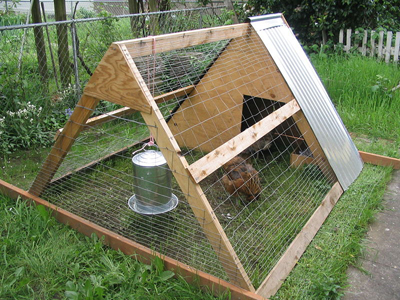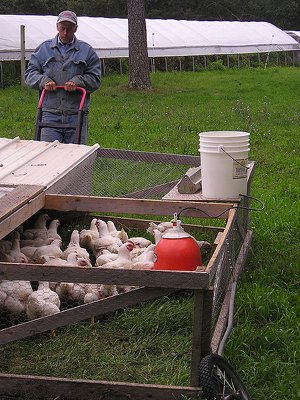Chicken Tractor
A Movable Chicken Pen

A chicken tractor is truly a wonderful thing. On the homestead or in the backyard, these floorless, movable chicken coops allow you to fully utilize the benefits that chickens offer.
Most movable chicken pens are built with a wooden skeleton and chicken wire walls. They usually have a small sheltered area built into one end that contains a roost (a horizontal stick that the chickens sleep on) and a nesting box (for laying eggs). Dimensions vary depending on the number of chickens, but the tractors are usually 4 to 10 feet wide and 6 to 15 feet long. Most tractors also contain a water source and a feeder.
What size should your chicken tractor be?
The amount of birds in a flock will dictate the square footage of the tractor. It is a ratio of 1-2 birds per 3 square feet of space. So if you live in the city with a 6 bird flock you would probably build a 4 ft. x 5ft. tractor. If you are raising a big flock of 40 meat chickens on pasture, then you are looking at a 5ft. x 12 ft. pen. I know of one farmer who keeps 70 birds in a 10 ft. x 12 ft. tractor.

Movable chicken pens allow chickens to find bugs and plants to eat. This is the diet that chickens would have if left to their own devices. Other game birds like wild pheasants eat more bugs and plants than they do grains. Chickens belong to the same scientific family as many of these game birds. Have you ever watched chickens that are fed an all grain diet? They eat the feathers off each other’s backs due to the lack of calcium! Insect exoskeletons provide this essential nutrient to chickens in well managed tractor systems.
The chickens aren’t the only ones who benefit from a tractor system. The holistic gardener can use chickens in a tractor to fertilize their garden beds after the fall harvest. The birds will eat any remaining pests and do some autumn weeding. They will be happy to mow your lawn.
Be More Prepared For Your Next Outdoor Adventure!

Don't leave without knowing these six essential survival skills. Our free survival mini guide reveals the strategies of:
- Shelter & fire to prevent the number one cause of death
- Obtaining clean water to avoid life-threatening dehydration
- Common wild survival foods and other critical skills!

Let’s compare the chicken tractor to other flock management systems.
The chicken pen or run is a closed off area much like the tractor. The difference is it doesn’t move. If chickens are on the same ground for an extended period of time, that ground will become void of life. It will become bare dirt. A mud pit. The flock manager must buy more food and import it into the chicken living quarters constantly. The one benefit a fixed pen has over a tractor is more protection from predators (especially those that dig).
Free range chickens (birds that are able to forage where they wish) are probably the healthiest of all. They can access food at the base of trees and shrubs where a tractor could not be placed. However, there are two downsides to free ranging birds that a chicken tractor would relieve. One downside is the susceptibility to predation from above (hawks), alongside (weasels and raccoons), and below (gigantic rats). The other downside is the chickens scratching ground that you don’t want them to scratch and eating plants you don’t want them to eat.
The moveable chicken pen benefits the gardener, the chicken, and the ecology of a homestead. It provides the protection of a pen and the fresh ground of free range. It takes a few minutes every day to move the tractor, but the benefits heavily outweigh the drawbacks.
By the way, a big part of why we love homesteading & permaculture skills so much is because they are a natural extension of learning about wilderness survival (both fields are all about self-sufficiency and working with nature to satisfy needs). An understanding of survival not only helps you become a better permaculturist, it empowers you with life-saving outdoor skills to keep you safe when out in nature. Right now you can get a free copy of our mini survival guide here, where you'll discover six key strategies for outdoor emergencies, plus often-overlooked survival tips.
Resources
Chicken Tractor: The Permaculture Guide to Happy Hens and Healthy Soilby Andy W. Lee & Patricia L. Foreman
Backyard Chickens' Guide to Coops and Tractors: Planning, Building, and Real-Life Advice by Members of Backyard Chickens.com
Related Courses:
Permaculture Course at Alderleaf Wilderness College

About the Author: Steve Nicolini is an experienced permaculturist and wilderness skills instructor. He taught at Alderleaf for a number of years. Learn more about Steve Nicolini.
Return from Chicken Tractor back to Permaculture Articles
Is The Essential Wilderness Survival Skills Course Right for You? Take the "Online Survival Training Readiness" Quiz
See for yourself if this eye-opening course is a good fit for you. It takes just a few minutes! Get your Survival Training Readiness Score Now!

Grow Your Outdoor Skills! Get monthly updates on new wilderness skills, upcoming courses, and special opportunities. Join the free Alderleaf eNews and as a welcome gift you'll get a copy of our Mini Survival Guide.

 The Six Keys to Survival: Get a free copy of our survival mini-guide and monthly tips!
The Six Keys to Survival: Get a free copy of our survival mini-guide and monthly tips!
Learn more